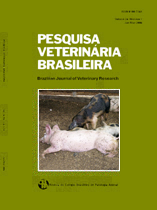 |
|
|
|
Year 2012 - Volume 32, Number 11
|

|
Leishmanicidal and cholinesterase inhibiting acti-vities of phenolic compounds of Dimorphandra gardneriana and Platymiscium floribun-dum, native plants from Caatinga biome, 32(11):1164-1168
|
ABSTRACT.- Vila-Nova N.S., Morais S.M., Falcão M.J.C., Bevilaqua C.M.L., Rondon F.C.M., Wilson M.E., Vieira I.G.P. & Andrade H.F. 2012. Leishmanicidal and cholinesterase inhibiting activities of phenolic compounds of Dimorphandra gardneriana and Platymiscium floribundum, native plants from Caatinga biome. Pesquisa Veterinária Brasileira 32(11):1164-1168. Centro de Ciências e Tecnologia, Universidade Estadual do Ceará, Av. Paranjana 1700, Campus do Itaperi, Fortaleza, CE 60740-000, Brazil. E-mail: selenemaiademorais@gmail.com
In recent years, the Brazilian Health Ministry and the World Health Organization have supported research into new technologies that may contribute to the surveillance, new treatments, and control of visceral leishmaniasis within the country. In light of this, the aim of this study was to isolate compounds from plants of the Caatinga biome, and to investigate their toxicity against promastigote and amastigote forms of Leishmania infantum chagasi, the main responsible parasite for South American visceral leishmaniasis, and evaluate their ability to inhibit acetylcholinesterase enzyme (AChE). A screen assay using luciferase-expressing promastigote form and an in situ ELISA assay were used to measure the viability of promastigote and amastigote forms, respectively, after exposure to these substances. The MTT colorimetric assay was performed to determine the toxicity of these compounds in murine monocytic RAW 264.7 cell line. All compounds were tested in vitro for their anti-cholinesterase properties. A coumarin, scoparone, was isolated from Platymiscium floribundum stems, and the flavonoids rutin and quercetin were isolated from Dimorphandra gardneriana beans. These compounds were purified using silica gel column chromatography, eluted with organic solvents in mixtures of increasing polarity, and identified by spectral analysis. In the leishmanicidal assays, the compounds showed dose-dependent efficacy against the extracellular promastigote forms, with an EC50 for scoporone of 21.4µg/mL, quercetin and rutin 26 and 30.3µg/mL, respectively. The flavonoids presented comparable results to the positive control drug, amphotericin B, against the amastigote forms with EC50 for quercetin and rutin of 10.6 and 43.3µg/mL, respectively. All compounds inhibited AChE with inhibition zones varying from 0.8 to 0.6, indicating a possible mechanism of action for leishmacicidal activity. |
| |
|
|
| |
|
 |